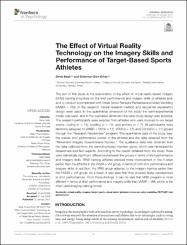| dc.contributor.author | Bedir, D. | |
| dc.contributor.author | Erhan, S.E. | |
| dc.date.accessioned | 2022-05-11T14:04:51Z | |
| dc.date.available | 2022-05-11T14:04:51Z | |
| dc.date.issued | 2021 | |
| dc.identifier.issn | 1664-1078 | |
| dc.identifier.uri | https://doi.org/10.3389/fpsyg.2020.02073 | |
| dc.identifier.uri | https://hdl.handle.net/20.500.11776/4808 | |
| dc.description.abstract | The aim of this study is the examination of the effect of virtual reality based imagery (VRBI) training programs on the shot performance and imagery skills of athletes and, and to conduct a comparison with Visual Motor Behavior Rehearsal and Video Modeling (VMBR + VM). In the research, mixed research method and sequential explanatory design were used. In the quantitative dimension of the study the semi-experimental model was used, and in the qualitative dimension the case study design was adopted. The research participants were selected from athletes who were involved in our target sports: curling (n = 14), bowling (n = 13), and archery (n = 7). All participants were randomly assigned to VMBR + VM (n = 11), VRBI (n = 12), and Control (n = 11) groups through the “Research Randomizer” program. The quantitative data of the study was: the weekly shot performance scores of the athletes and the data obtained from the “Movement Imagery Questionnaire-Revised.” The qualitative data was obtained from the data collected from the semi-structured interview guide, which was developed by researchers and field experts. According to the results obtained from the study, there were statistically significant differences between the groups in terms of shot performance and imagery skills. VRBI training athletes showed more improvement in the 4-week period than the athletes in the VMBR + VM group, in terms of both shot performance and imagery skills. In addition, the VRBI group adapted to the imagery training earlier than the VMBR + VM group. As a result, it was seen that they showed faster development in shot performances. From these findings, it can be said that VRBI program is more efficient in terms of shot performance and imagery skills than VMBR + VM, which is the most used imaging training model. © Copyright © 2021 Bedir and Erhan. | en_US |
| dc.description.sponsorship | We thank the participants and students of Atat?rk University Faculty of Sport Sciences, Selim Can Da??stanl? and Irem Ba?adur. | en_US |
| dc.language.iso | eng | en_US |
| dc.publisher | Frontiers Media S.A. | en_US |
| dc.identifier.doi | 10.3389/fpsyg.2020.02073 | |
| dc.rights | info:eu-repo/semantics/openAccess | en_US |
| dc.subject | imagery | en_US |
| dc.subject | PETTLEP | en_US |
| dc.subject | shot performance | en_US |
| dc.subject | target sports | en_US |
| dc.subject | video modeling | en_US |
| dc.subject | virtual reality | en_US |
| dc.subject | visual motor behavior rehearsal | en_US |
| dc.title | The Effect of Virtual Reality Technology on the Imagery Skills and Performance of Target-Based Sports Athletes | en_US |
| dc.type | article | en_US |
| dc.relation.ispartof | Frontiers in Psychology | en_US |
| dc.department | Fakülteler, Spor Bilimleri Fakültesi, Beden Eğitimi ve Spor Eğitimi Bölümü | en_US |
| dc.identifier.volume | 11 | en_US |
| dc.institutionauthor | Erhan, S.E. | |
| dc.relation.publicationcategory | Makale - Uluslararası Hakemli Dergi - Kurum Öğretim Elemanı | en_US |
| dc.authorscopusid | 57221912446 | |
| dc.authorscopusid | 57221911939 | |
| dc.identifier.wos | WOS:000614629800001 | en_US |
| dc.identifier.scopus | 2-s2.0-85100552289 | en_US |



















